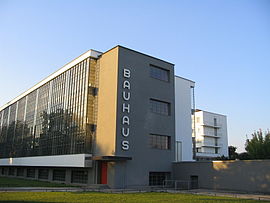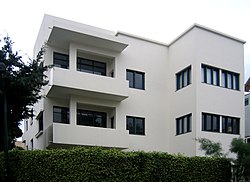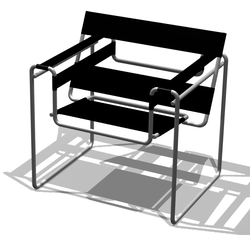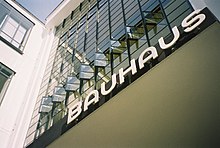Bauhaus school
The Staatliche Bauhaus ('House of State Building'), or simply Bauhaus, was the school of architecture, design, crafts and art founded in 1919 by Walter Gropius in Weimar (Germany).
Architects, sculptors, painters, we must return to manual work... Let us therefore establish a new confraternity of craftsmen, free from that arrogance that divides the social classes and seeks to erect an infranchable barrier between the artisans and the artists.Walter Gropius
Name
The name Bauhaus derives from the union of the German words Bau, "construction", and Haus, "home"; Ironically, despite its name and the fact that its founder was an architect, the Bauhaus did not have an architecture department in the early years of its existence.
Its proposals and declarations of intent shared the idea of a necessary reform of artistic education as a basis for a consequent transformation of the bourgeois society of the time, in accordance with the thought of its founder. The first phase (1919-1923) was idealistic and romantic; the second (1923-1925), much more rationalist, and in the third (1925-1929) he achieved his greatest recognition, coinciding with his transfer from Weimar to Dessau. In 1930, under the direction of Mies van der Rohe, he moved to Berlin, where he completely changed the orientation of his teaching program.
Founding ideology
The Bauhaus or Staatliche Bauhaus (State Building House) is a school of crafts, arts, design and architecture whose contributions are visible to this day.
Walter Adolph Georg Gropius, founder of the Bauhaus, was born in Berlin on May 18, 1883. The son and grandson of architects, he studied architecture in Munich and Berlin. One of Gropius's main ideals was represented by the following phrase: "Form follows function". He was looking for the union between use and aesthetics.
His career is a circumstance that must be considered decisive for Gropius's ideological orientation. Coming from the intelligent bourgeoisie, he worked in Munich from 1907 to 1910 with Peter Behrens, the first architect to be hired by a large industrial company as artistic manager (AEG). From then on, Gropius always raised the problem of building in relation to the industrial system and mass production, even going so far as to consider the building as a direct product of industry and thus founding in 1943, together with Konrad Wachsmann, a precast building company.
The Fagus factory, of revolutionary architecture, gave it some fame in 1911 —which it confirmed in Cologne in 1914— by building a palace for offices with a daring structural, aesthetic and technical conception for the Werkbund exhibition. The Great War interrupted his activity as a builder, claimed to the front. But during those years he was growing in his mind the awareness that he had a very high human duty to fulfill: architecture had to play a role in the social problem that the postwar period would pose with all seriousness; and this social problem had to merge with aesthetics.
Gropius did not allow women to study architecture at the Bauhaus, contrary to the laws of the Weimar Republic establishing universal education, and the promises of equality with which the school was promoted. However, women were allowed to participate in textile or ceramic workshops.
Later the curriculum was modified and these centers were changed by workshops where students worked alongside teachers, such as Gropius in the furniture workshop, Schlemmer in stone sculpture and Kandinsky in mural painting.
Relation to design
The Bauhaus laid the normative bases and patterns of what we know today as industrial and graphic design; it can be said that before the existence of the Bauhaus these two professions did not exist as such and were conceived within this school. Undoubtedly, the school established the academic foundations on which one of the most predominant trends of the new Modern Architecture would be based to a large extent, incorporating a new aesthetic that would cover all areas of daily life: from the chair to the that you sit down to the page you are reading (Heinrich von Eckardt). Given their importance, the Bauhaus works in Weimar and Dessau were declared a World Heritage Site by UNESCO in 1996.
When Ludwig Mies van der Rohe was director, the school suffered from increasing harassment by Nazism. Because the Bauhaus ideology was seen as Jewish-socialist, the Nazis closed the school.
Many of its members, among them Walter Gropius himself, refugees, finally settled in the United States to continue with their ideals.
The Bauhaus had its headquarters in three cities:
- 1919-1925: Weimar
- 1925-1932: Dessau
- 1932-1933: Berlin
And it was organized by three directors:
- 1919-1928: Walter Gropius
- 1928-1930: Hannes Meyer
- 1930-1933: Ludwig Mies van der Rohe
The legacy of the Bauhaus School has a strong influence on design educational institutions around the world today, keeping their stances away from the dividing lines between disciplines and towards the functional.
The Bauhaus and the new typography
According to Philip B.Meggs, the Bauhaus generated a new typeface style in its school of design (1919-1933). Sans-serif typefaces were used almost exclusively, and Bayer designed a universal type that reduced the alphabet to clean, simple, and rationally constructed forms.
Architecture
One of the principles established by the Bauhaus since its foundation is "Form follows function"
The building of the Bauhaus in Dessau (1925-1932) by Walter Gropius, is the most emblematic of its schools. It unfolds in various volumes, independent of each other, and designed according to the function for which they were conceived. It has a configuration related to the conditions of the area where it is located: it borders a street, crosses another perpendicular to the first, and two of its wings surround a nearby sports field, and it opens up to the rhythm of urban life with its large facades of bright windows. This project is considered the masterpiece of European rationalism.
Tel Aviv is the city with the most Bauhaus architecture. There are more buildings built in the Bauhaus style than anywhere else in the world, including any city in Germany. The style was carried over in the 1930s by European architects, mostly German and Russian, from the Bauhaus school who were fleeing the Nazi regime. Since 2003, "The White City" It is considered a World Heritage Site, and there are more than 4,000 Bauhaus and international style buildings recorded and subject to different restoration and preservation plans.
Photography
The Bauhaus did not have a photographic section, but in 1923 the metal workshop was entrusted to the Hungarian master László Moholy-Nagy who then introduced photography as a new means of artistic expression. He taught techniques such as photomontage, lighting montage, photo sculpture, and collage, paving the way in this field. He encouraged, within the framework of photographic expression, the exploration of new forms rather than new themes. One of the essential innovations of this school was undoubtedly that of having systematically associated art with its possible applications, whether documentary, decorative or advertising. Great photographers studied at the Bauhaus such as Herbert Bayer, Lucía Moholy-Nagy, Walter Peterhans, Horacio Coppola, Florence Henry, Grete Stern and Ellen Auerbach, among others.
Historical-political context
The founding of the Bauhaus occurred at a time of crisis in modern thought and Western technical rationality in Europe as a whole and particularly in Germany. Its creation was due to the confluence of a set of political, social, educational and artistic developments in the first two decades of the XX century, whose specificity is given by the artistic vanguards of the beginning of the century.
The conservative modernization of the German Empire during the 1870s kept power in the hands of the aristocracy. This also required militarism and imperialism to maintain stability. By 1912 the rise of the leftists of the SPD had galvanized political positions with concepts of international solidarity and establishing socialism against imperialist nationalism. Sectors of the proletariat demonstrated a growing capacity for organization, an issue that was inevitably promoted by German hyperinflation and the increasingly evident economic crisis. Like other movements belonging to the artistic avant-garde, some of its members maintained a high degree of critical content and commitment to the left, but the Bauhaus as an institution remained outside the political-social processes. Despite this, and as a consequence of the rebellion of some of its students, the Bauhaus —as demonstrated by the problems it had with politicians who did not see it with sympathy— acquired the reputation of being profoundly subversive.
Timeline
First period (1919-1923)
At the time of its foundation the objectives of the school, characterized by Gropius in a manifesto, were: "The recovery of artisanal methods in the construction activity, raising the artisanal power to the same level as the Fine Arts and try to commercialize the products that, integrated into industrial production, would become affordable consumer objects for the general public" since one of his goals was to become independent and start selling the products made at the School, to stop depending on the State that until then was the one who subsidized them.
It was formed when Gropius unites the School of Fine Arts with the School of Applied Arts or School of Arts and Crafts, transforming it into the first design school in the world. In 1919, the founding manifesto of the Bauhaus was published in Der Austausch, the student newsletter. In this phase, the so-called "vorkurs" or preliminary course, created by Johannes Itten. As his name indicates, the preliminary course, prior to the studies themselves, had the mission of freeing the future member of the institution from conventions, awakening his personal gifts and spiritually guiding him for further training. Early students included Marcel Lajos Breuer and Joost Schmidt, who achieved some success. The students were flexible and willing to do all kinds of jobs, so they left school well trained, knowing how to draw, model, photograph or design furniture. The school had workshops for carpentry, design, theatre, ceramics, weaving, bookbinding, metallurgy, glassmaking. But not painting and sculpture in the traditional sense.
The theater workshop, directed by Oskar Schlemmer, was considered very important within the school's program due to its nature as a social activity that combined various means of expression. Decorations, costumes, etc. They were part of the students' practices. Schlemmer's works were famous, especially the Triadic Ballet, a work premiered at the Stuttgart theater.
Paul Klee arrived at the school in 1920. A highly educated person (in addition to being a notable violinist and painter) very interested in the theoretical problems of art. He developed his activity in the weaving workshop, giving composition classes. His teaching was based on the elementary forms, from which, according to him, all the others were derived. Art had to discover those forms, unveil them, make them visible. He conscientiously prepared the classes by writing in notebooks that were later published in book form.
In 1922 Kandinsky joined the project. He had participated in the educational reforms at the time of the Russian revolution, founding several schools in the Soviet Union. During that time he corresponded with Gropius. When the Russian revolution began to suffer difficulties and political disputes and purges began, Kandinsky decided to transfer to the Bauhaus. His prestige, after the publication of On the Spiritual in Art in 1911 and his first abstract works of 1910, was by then already very great. He replaced Schlemmer in the mural painting workshop and taught with Klee in the basic design course. His theoretical mind was decisive in starting the path towards a more intellectual and reasoned art, where they used the soul of the object to sculpt it on the canvas with abstract features.
Klee retired in 1931.
This first stage culminates with the imminent need to change the location of the school caused by the great depression. The first stage of the Bauhaus can be synthesized as a phase of experimentation with shapes, products and designs and, therefore, also with design educators.
Second period (1923-1925)
In 1923 Theo van Doesburg, founder of Neo-Plasticism in the Netherlands, painter, architect and theoretician, created the magazine and movement De Stijl in the Netherlands and, later arriving in Weimar, exerted an influence decisive in the students and in Gropius, which would end up leading the school to take another course.
Starting in 1923, the previous expressionist trend was replaced by the New Objectivity, an expressionist style of painting, although much more sober, that was prevailing throughout Germany. The incorporation into the Bauhaus of László Moholy-Nagy, an artist very close to Van Doesburg, meant the introduction into the school of the ideas of Russian Constructivism of El Lissitzky and Tatlin, who advocated a communal art, based on the idea and not on inspiration.
Some of the most important theoretical writings of the Bauhaus in the field of painting date from this period. Thus, Klee writes «Ways of the study of nature» (Wege des Naturstudiums, 1923) and «Pedagogical sketchbook» (Pädagogisches Skizzenbuch, 1925); He gives the lecture Modern Art ( Über die moderne Kunst ) at the Jena Art Association. For his part, Kandinsky published «Point and line on the plane» ( Punkt und Linie zu Fläche , 1926) as number 9 of the Bauhaus series. Dessau headquarters.
Third period (1925-1933)
In 1928, after five years of teaching, László Moholy-Nagy left the Bauhaus, a decision made before the growing pressure exerted by the group of teachers and students with a communist tendency.
In 1933 the Nazi party decided to close the school, so Ludwig Mies van der Rohe moved the Bauhaus to Berlin with funds earned from the illegal closing of contracts. The school, located this time in an old telephone building, would only survive until April of that same year. The protests of Van der Rohe, who insisted on presenting himself as a patriot and war veteran and defending that his work had no political implications, were useless.
To the Bauhaus we owe innovations such as functionality, interdiscipline, the professionalization of creative disciplines and experimentation. In addition, it continues to be a strong influence for design educational institutions around the world.
Daily life and festivals at the Bauhaus
The Bauhaus was also a great vital experiment of a small community of young people (approximately 1,400) who, after the bankruptcy of the old order and the traumatic experience of the recently ended First World War, threw themselves enthusiastically into the construction of a social utopia, of new forms of coexistence. Legendary parties were held at the Bauhaus, usually themed (white party, metal party, comet party) and almost always costumes, the organization and design of which was worked on for weeks. The festivities had a double intention: on the one hand, to promote contact between the school and the population to appease the misgivings that the institution generated in the population and, on the other, to promote teamwork and cooperation and serve as a catharsis in the face of tensions. and conflicts that originated in the Bauhaus as a result of the close relationship between work and private life. In addition to these "official" parties, any event was equally likely to lead to a celebration: the completion of a tapestry, the acquisition of the Kandinsky couple's nationality, or the birth of a child.
The New Bauhaus
After 1933, a large part of the members of the Bauhaus marched towards the United States, where a kind of continuation of the Bauhaus developed until the Cold War. László Moholy-Nagy founded the New Bauhaus in Chicago in 1937. Of the new incarnations of the school, this would be the one that would most closely adhere to the original curriculum. In 1951, the Swiss architect and sculptor Max Bill, following the guidelines of the original Bauhaus, founded the Hochschule für Gestaltung (Higher School of Projection) in Ulm (Federal Republic of Germany), which soon recovered the name of Bauhaus or, to differentiate it from the initial, Neues Bauhaus (New Bauhaus), of which the Argentine painter and designer Tomás Maldonado was director between 1954-1966, who further emphasized the scientific and rationalist character applied in the arts.
Main exponents of the Bauhaus
- Wassily Kandinsky (1866-1944), painter.
- Lyonel Feininger (1871-1956), art painter and photographer.
- Paul Klee (1879-1940), painter.
- Walter Gropius (1883-1969), architect.
- Lilly Reich (1885-1947), architect and interior designer.
- Ludwig Mies Van der Rohe (1886-1969), architect.
- Lucia Moholy photographer.
- Ludwig Hilberseimer (1885-1967), architect and urbanist.
- Gertrud Arndt designer and photographer.
- Lothar Schreyer (1886-1966), writer, playwright and painter.
- Anni Albers textile artist.
- Josef Albers (1888-1976), art painter and teacher.
- Alma Buscher designer.
- Johannes Itten (1888-1967), art painter and teacher.
- Marianne Brandt sculptor.
- Oskar Schlemmer (1888-1943), painter.
- Lilly Reich designer.
- Otti Berger texil artist.
- Gerhard Marcks (1889-1940), painter and sculptor.
- Hannes Meyer (1889-1954), architect.
- Lis Beyer textile artist.
- Marianne Brandt (1893-1983), a metal designer.
- Joost Schmidt (1893-1948), typographer and sculptor.
- Ellen Auerbach photographer.
- Laszlo Moholy-Nagy (1895-1946), visual designer.
- Georg Muche (1895-1987), painter and graphist.
- Hilde Hubbuch photographer.
- Gunta Stölzl (1897-1983), weaver.
- Walter Peterhans (1897-1960), photographer.
- Elisabeth Kadow textile artist.
- Annelise Kretschmer photographer.
- Hinnerk Scheper (1897-1957), colorist, painter and curator of monuments.
- Alfred Arndt (1898-1976), architect.
- Dörte Helm (1898-1941), painter and graphic designer.
- Anni Albers (1899-1994), textile designer and recorder.
- Arieh Sharon (1900-1984), architect.
- Herbert Bayer (1900-1985), graphic designer and painter.
- Marcel Breuer (1902-1981), architect and designer
- Lotte Beese (1903-1988), arquitecta y urbanista
- Xanti Schawinsky (1904-1979), painter, sketch artist, designer and photographer.
- Grete Stern (1904-1999), designer and photographer.
- Horacio Cóppola (1906-2012), photographer.
Composition
| Year | City | Director | Title of the preliminary course |
|---|---|---|---|
| 1919 | Weimar | Walter Gropius | Johannes Itten |
| 1923 | Weimar | Walter Gropius | Laszló Moholy-Nagy |
| 1925 | Weimar | Walter Gropius | Laszló Moholy-Nagy |
| 1925 | Dessau | Walter Gropius | Laszló Moholy-Nagy |
| 1928 | Dessau | Hannes Meyer | Josef Albers |
| 1930 | Dessau | Ludwig Mies van der Rohe | Josef Albers |
| 1932 | Dessau | Ludwig Mies van der Rohe | Josef Albers |
| 1932 | Berlin | Ludwig Mies van der Rohe | Josef Albers |
| 1933 | Berlin | Ludwig Mies van der Rohe | Josef Albers |
| Closure | |||
1919 Curriculum
- A preliminary course (6 months): formal education
- Elementary through the study of subjects in educational techniques
- Workshop-based education (3 years)
- The artist was responsible for technical teaching (color theory courses, materials and utensils, composition, space)
- The artisan of formal teaching. 7 workshops: stone, wood, metal, clay, glass, colors and fabrics. (Diploma de artesano)
- A training course
- Realization of an architectural project. Practical work at school workshops. (Diploma of art teacher)
- 3 pillars: Craft training; Graphical-pictorial training; Scientific training.
The Bauhaus aspires to train creative artists.
World Heritage Site
The Bauhaus and its sites in Weimar and Dessau is the set of Bauhaus buildings declared a World Heritage Site by Unesco in 1996. The Unesco description reads:
Between 1919 and 1933, the Bauhaus movement revolutionized architectural and aesthetic thinking and practice of the twentieth century. The Bauhaus buildings in Weimar, Dessau and Bernau are fundamental representatives of classic modernism, aimed at a radical renovation of architecture and design. The site, registered in the World Heritage List in 1996, included buildings located in Weimar (former School of Arts, School of Applied Arts and Haus Am Horn) and Desau (Edificio Bauhaus, Group of the Seven Master Houses). The expansion of 2017 includes five blocks of three-storey social housing – with balcony access – built with brick in Desau, and the General Confederation of Trade Unions of Germany (ADGB) School built in Bernau, as important contributions to the ideals of the Bauhaus depurado design, functionalism and social reform.Entrance «La Bauhaus and its sites in Weimar, Desau and Bernau»
It is made up of the following monuments:
| Code | Name | Location | Area protection (ha) | Area tampon (ha) | Coordinates |
|---|---|---|---|---|---|
| 729-001 | Old Art Building (Main Building of the Weimar Academy for Architecture and Constructive Arts) | Weimar University | 0.24 | 2.4 | 50°58′29.2′N 11°19′46.2′′E / 50.974778, 11.329500 (Bauhaus School: Weimar Academy) |
| 729-002 | Former Applied Arts School (Academy for Architecture and Constructive Arts Van de Velde Building) | Weimar University | 0.27 | 50°58′29′′N 11°19′45.7′E / 50.97472, 11.329361 (Bauhaus School: Van de Velde Building) | |
| 729-003 | Haus am Horn | Weimar | 0.25 | 9,5 | 50°58′24.3′N 11°20′20.9′′E / 50.973417, 11.339139 (Bauhaus School: Haus am Horn) |
| 729-004 | Bauhaus Building | Dessau | 1.73 | 4.05 | 51°50′18.4′N 12°13′38.2′′E / 51.838444, 12.227278 (Bauhaus School: Bauhaus Building) |
| 729-005 | Houses of the Masters | Dessau | 1.26 | 3,44 | 51°50′36.1′N 12°13′17.5′′E / 51.843361, 12.221528 (Bauhaus School: Houses of Masters) |
| 729bis-006 | House with balcony access - Peterholzstr. 40 | Dessau | 0.19 | 25,03 | 51°48′10.82′N 12°14′36.23′′E / 51.8030056, 12.2433972 (Peterholzstr. 40) |
| 729bis-007 | House with balcony access - Peterholzstr. 48 | Dessau | 0.19 | 51°48′10.82′N 12°14′42.84′′E / 51.8030056, 12.2452333 (Peterholzstr. 48) | |
| 729bis-008 | House with balcony access - Peterholzstr. 56 | Dessau | 0.19 | 51°48′10.55′N 12°14′49.29′′E / 51.8029306, 12.2470250 (Peterholzstr. 56) | |
| 729bis-009 | House with balcony access - Mittelbreite 6 | Dessau | 0.21 | 51°48′3.59′N 12°14′32.69′E / 51.8009972, 12.2424139 (Mittelbreite 6) | |
| 729bis-010 | House with balcony access - Mittelbreite 14 | Dessau | 0.19 | 51°48′3.59′N 12°14′39.18′′E / 51.8009972, 12.2442167 (Mittelbreite 14) | |
| 729bis-011 | ADGB Trade Union School | Bernau bei Berlin | 3,4414 | 17,24 | 52°42′24′N 13°32′39′′E / 52.70667, 13.54417 (AdGB Trade Union School) |
In 2019, the digital search engine Google launched a digital collection inspired by the style of the Bauhaus School. The exhibition has 45 exhibits, more than 10,000 objects and 400 digitized images, and is guided on Google Maps. In addition, you can visit buildings that were never built
In November 2019, the Ariston hostel in the Argentine city of Mar del Plata, and the only work by Marcel Breur in Latin America, was declared a National Historic Monument.
The objective is to value the building, which has been abandoned since 1993.
This hostel was also built together with the Argentine architects Eduardo Catalano and Carlos Coire.
In addition, the construction was paid for by the Faculty of Architecture of the University of Buenos Aires.
Contenido relacionado
Dogali
Pachacamac (archaeological site)
Slapstick












